
JANUARY, 2017 NEWSLETTER FOR FRIENDS OF ST. MARKS WILDLIFE REFUGE
|
Reflections newsletter is a benefit of membership for Friends of St. Marks Wildlife Refuge. It also serves as an important supplement to
the
Friends' web site,
www.stmarksrefuge.org.
Both the newsletter and the web site provide members and the public information about volunteer activities and events at the Refuge.
|
|
|
|
Whooping Crane Activity Update
Things are looking up for whooping cranes wintering at St. Marks National Wildlife Refuge!
Early 2016 was a tough period of time, as news of a decision to end ultralight-guided migration reached the Refuge before the young cranes of 2015 arrived. Many wondered what would be the fate of adult cranes returning to St. Marks in coming years. Would the pen that protected them be maintained?
Only "parent-reared" whooping cranes raised in captivity or in the wild were meant to augment the Eastern Migratory Population in the future. Would any of them be adopted by St. Marks' adult cranes, so the young could learn the migratory pathway to the Gulf coast? Was there a "Plan B" to help young whoopers migrate if they were not adopted by experienced birds? So many questions were unanswered. 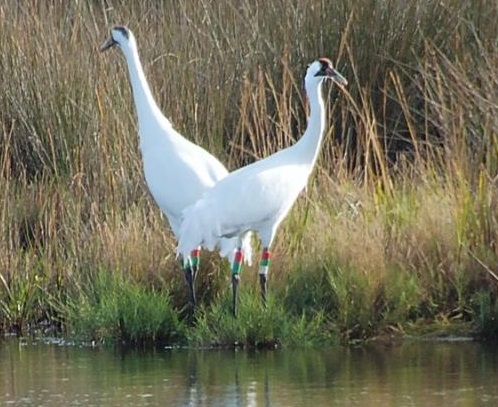
LEFT Adult whooping cranes in marsh near St. Marks NWR winter crane pen. Credit St. Marks NWR
Hurricane Hermine hit on September 2nd. The Refuge coast became ground zero - 6 foot storm surges and 80 mph winds downed trees, killed phone and internet service, damaged infrastructure, and mountains of sea grasses and trash plastered coastal vegetation and the Lighthouse parking lot. Many staff and volunteers' homes sustained damage and lost electricity for a week or more. But Refuge staff managed to open the Visitor Center the next day, September 3rd.
While Refuge staff and crews cleared roads and repaired levees, Friends of all ages donated many hours of sweat equity to the Refuge on Coastal Cleanup and Public Lands Day. And we wondered: Did the crane pen survive?
Refuge Manager Terry Peacock reported good news in late September: WCEP (Whooping Crane Eastern Partnership) approved using the pen in 2016 to protect and help monitor wintering cranes. And storm damage to the "Whooper Hilton" could be repaired. Terry came up with a plan to provide the Friends' Carney interns a great educational opportunity to participate in pen repairs and monitor arriving cranes.
 LEFT - Whooping Crane pen fence repair team, St. Marks NWR, 2016. Photo credit: Refuge Volunteer.
LEFT - Whooping Crane pen fence repair team, St. Marks NWR, 2016. Photo credit: Refuge Volunteer.
Work days were held on October 15 and November 18. Friends' members - including participants in Visitor Services, Milkweed Mafia and the FSU Environmental Service Program, along with interns, the Photo Club, RV volunteers and local citizens, helped Refuge staff. They repaired fencing, reinforced the oyster bar where the cranes roost, replaced zip-ties on the wind-whipped topnet of the small inner pen, swept out the viewing blind, and removed flooring from the feed sheds and storm debris on the marsh. 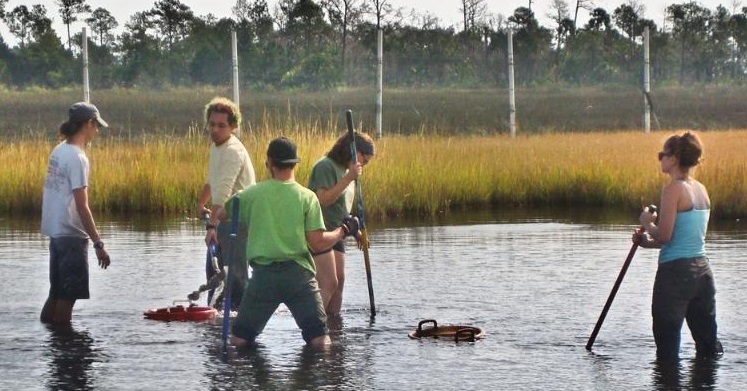
RIGHT - Oyster bar roost repairs by FSU Environmental Service Program team. Photo credit: Refuge Volunteer.
Refuge staff and other crews later continued with repairs to the freshwater system and electric fence, carpentry to reinforce gates, and many hours on a "Marsh Master" machine that flattens vegetation to eliminate hiding places for predators like coyotes and bobcats. 
RIGHT - Crane Pen Team at the end of a day's work. Photo credit, volunteer.
Then, more happy news: Brooke Pennypacker of Operation Migration would soon return to St. Marks to monitor the cranes until their spring journey north. Winter is always merrier with his colorful tales
Article credit - Dedicated Refuge Volunteer
|
Our Piece of the National Scenic Trail
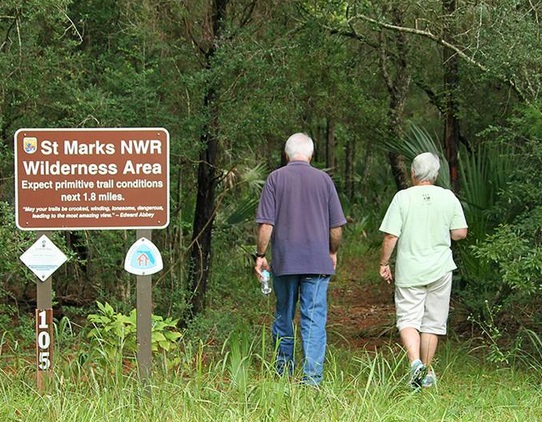
Our National Scenic Trails System includes designated trails in 11 states, one of which is Florida. The Florida National Scenic Trail stretches over 1,000 miles, from Big Cypress Swamp near the Everglades, to Ft. Pickers, part of the Gulf Islands National Seashore near Pensacola. Just a little less than 50 miles of Florida's trail passes through our Refuge.
Many people are drawn to scenic trails for recreational opportunities, especially hiking, but in places like the St. Marks National Wildlife Refuge, these trails have the important additional function of facilitating access to some of the more isolated
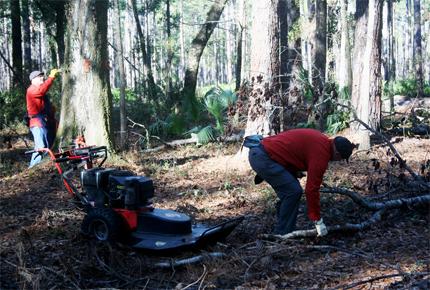 areas and attractions. At St. Marks, examples include the Port Leon
townsite, Cathedral of the Palms, Shepherd Springs and 17,000 acres that make up the congressionally-designated St. Marks Wilderness Area. Only "through hikers" (those who are hiking long-distance on the Florida Trail) are allowed to stay overnight at one of several designated primitive campsites on the Refuge, provided they first obtain a permit from the Visitors Center so they are not put at risk by timber harvesting operations or prescribed burns.
We encourage members of our Friend's Group to take advantage of the opportunity to visit some of the special places that is made possible by the Florida Trail, and to encourage their friends, neighbors, and co-workers to do so also. Wildlilfe viewing opportunities are abundant. And we want to encourage those familiar with the Florida Trail to consider volunteering some time and energy to maintain it. Each stretch of the National Scenic Trail has a volunteer group affiliated with it, that helps with its basic maintenance. The St. Marks portion of the National Scenic trail is being maintained this year by Refuge volunteers Steve Babcock, Harry Chiles, Phil Fleming, Paul Hamilton, Fred Jagels, Bill Phelan, and Kenneth Williams, all under the supervision of FWS Firefighter Travis Pollard. Larger jobs, such a footbridge replacement, are often accomplished by traveling trail maintenance crews consisting of volunteers with the skills and experience to deal with more complex tasks.
Article by Paul Hamilton, Photo credits; top, Lou Kellenberger, bottom, Paul Hamilton
|
The Annual Report is a Showcase of
Volunteer Expertise
Many of you who are now reading this issue of Reflections are volunteers. But for those of you who are not, consider this common dictionary definition of a volunteer: 'A person who freely offers to take part in an enterprise or undertake a task.' The key word here is freely.
Rita LeBlanc is a glowing example of a volunteer who provides exacting and professional life-long skills and knowledge to the Refuge
 -she performs this volunteer work happily. She receives no payment for her work. In fact, like so many of the Friends' volunteers, she has reservations about even being recognized. "I have been coming to the Refuge since the late 1970s," Rita commented. "I wanted to bring something to the Refuge that I was good at, something that I liked doing, and something that helped to make a difference." She added, "I'
m not someone who needs or likes a lot of recognition." What Rita is good at is design and layout. She works quietly and cheerfully, yet her work is BIG when it comes to Refuge significance.
-she performs this volunteer work happily. She receives no payment for her work. In fact, like so many of the Friends' volunteers, she has reservations about even being recognized. "I have been coming to the Refuge since the late 1970s," Rita commented. "I wanted to bring something to the Refuge that I was good at, something that I liked doing, and something that helped to make a difference." She added, "I'
m not someone who needs or likes a lot of recognition." What Rita is good at is design and layout. She works quietly and cheerfully, yet her work is BIG when it comes to Refuge significance.
 Since Rita re
tired from work as a type-setter for a design firm in Tallahassee about two-and-a-half years ago, she has helped to create stunning materials that attract new members to the Friends' group (Annual Report at left, Planned Gift and the Edward and Hilda Carney Wildlife Conservation Interns publications at bottom). In addition, these printed and electronic materials carry forward the important
mission of the Refuge. "I like creating a product," said Rita. "It's a bit like problem-solving or a puzzle-I want the end-product to be elegant, but it's also something that has to be functional so that I can easily adjust and modify it as the development progresses."
Since Rita re
tired from work as a type-setter for a design firm in Tallahassee about two-and-a-half years ago, she has helped to create stunning materials that attract new members to the Friends' group (Annual Report at left, Planned Gift and the Edward and Hilda Carney Wildlife Conservation Interns publications at bottom). In addition, these printed and electronic materials carry forward the important
mission of the Refuge. "I like creating a product," said Rita. "It's a bit like problem-solving or a puzzle-I want the end-product to be elegant, but it's also something that has to be functional so that I can easily adjust and modify it as the development progresses."
The annual report is an extremely fine example of Rita's skill as a designer or "builder" as she sometimes thinks of her skills. "An attractive document such as this is an invaluable tool for us as a 501(c)(3) non-profit," said Friends' Board of Directors' President, Mary Smallwood. "We can proudly hand this to people when we encourage them to support the Refuge vision. The report highlights conservation, research, and educational efforts that help to protect the rich, unique resources at St. Marks," she said.
The annual report is being highlighted in this story (above, left), because it 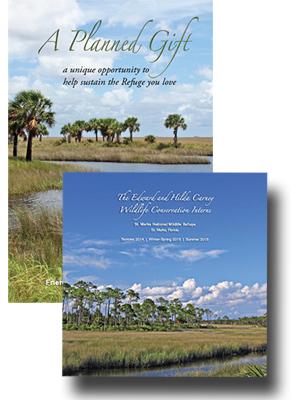 represents the work of so many volunteers. Rita said, "I admit that I make every attempt to make this document beautiful. It's fun to do that. But, there were so many others who made the report happen." represents the work of so many volunteers. Rita said, "I admit that I make every attempt to make this document beautiful. It's fun to do that. But, there were so many others who made the report happen."
The following is a brief summary of those individuals who worked on the report: The initial plan for the report was drafted by Paul and Betty Hamilton, John Haines and Rita. Melissa Jacoby, Sue Conte and Mary Smallwood wrote important segments of the report. Specifics about important initiatives at the Refuge, as well as supplemental written segments, came from Refuge staff Lori Nicholson, Joe Reinman, Gail Fishman, and Scott Davis. Other contributors were Chantal Blanton, Jim Young, Susan Cason, Joanne Harrington, and Phillip Pollock. Rita remarked, "John Haines provided the glue that held it all together-the writing and re-writing, editing, and last but certainly not least, the final opinion on whatever I needed, whenever I needed it. In all, what an amazing, wonderful team effort."
Don't misunderstand the tenor of this story. The Friends are not about back-patting; this one project simply conveys the depth, diversity and sincerity of volunteers who love to give. And, yes, they give freely.
|
Volunteers Needed
The Friends are actively seeking individuals who would enjoy volunteering and participate on the Membership Committee.
The Membership Committee is chaired by Board of Directors' member, Susan Cason. The committee itself, obviously, functions to maintain and expand the Friends' membership base. As such, the committee members maintain a data base, handle renewal and thank you notices, host functions to attract new members, and participate in Refuge-related activities that members enjoy.
With these committee tasks in mind, we are searching for individuals who are outgoing and who are good verbal and written communicators. In addition, we would like these volunteers to have great pride in the Refuge and its mission. Finally, we would love to see volunteers who are active and willing to conduct public hiking, kayaking, other similar outdoor activities.
If you are interested in this type of volunteering, please contact Susan Cason by email at sbcason07@comcast.net. Thank you.
|
Just when you thought that hitting your favorite hiking trail in search of another life-list addition was a way to escape technology, eBird and other applications come your way. But, before you gasp and say, "egads", read on.
eBird.com is a robust web site that helps you record and track birds you see, provides mapping and graphing tools, shares your sightings with others, and contributes to science and conservation. eBird.com was launched in
2002 by the Cornell Lab of Ornithology and National Audubon Society. It is a real-time, online checklist program that has revolutionized the way the birding community reports and accesses information about birds.
In addition to eBird, there are also phone applications that have become part of the birding community, especially for those on the trail who are new to bird-watching. An Audubon advice web page describes a number of electronic tools that assist with bird identification. Check them out to see if one fits with the way you categorize and identify your sightings.
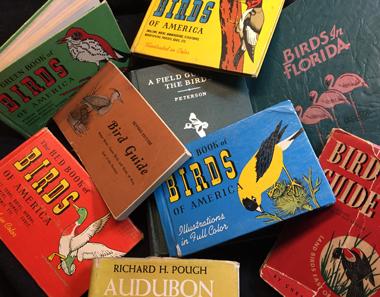 But, for the purist birder, nothing will ever replace the look and feel of your favorite, trusty paper field guide. Whether it's a Peterson, Audubon, Sibley, or even an ancient Red, Yellow, Blue or Green Book of Birds, an old field guide just, well, it just feels like the backyard-birding when you were a kid. But, for the purist birder, nothing will ever replace the look and feel of your favorite, trusty paper field guide. Whether it's a Peterson, Audubon, Sibley, or even an ancient Red, Yellow, Blue or Green Book of Birds, an old field guide just, well, it just feels like the backyard-birding when you were a kid.
|
WHO Festival, Saturday, February 4
The mid-winter season at the Refuge is highlighted b
y the annual WHO (Wildlife Heritage and Outdoors) Festival. This year's festival falls on Saturday, February 4, from 11:00 am until 4 pm.
Learn about the many and varied recreational opportunities offered at the Refuge. There will be wildlife exhibits inside the Visitor Center, a turkey call contest, fly fishing and archery how-to demonstrations, as well as many other activities.
 Each year, there is food available for purchase at the Visitor Center area, as well as live music. Inside, wildlife art work and other wildlife-related materials are exhibited.
Artwork shown here is from the 2016 St. Marks Wildlife Art Contest, on display in the Monarch Room at last year's festival . At top is the Best of Show 1st place winner in the 9-12 grade category - 'Northern Waterthrush' by Ashlee Maddi. Below is the Honorable Mention winner in the 6-8 grade category - 'An Owl in Flight' by Asiera Preston.
|
Winter Biscuit Brunch - Sunday, February 5
Break the winter doldrums with a nice warm biscuit brunch at the Refuge while you visit with like-minded friends about your experiences at the Refuge. We will have southern style biscuits with your choice of fillers - eggs, cheese, sausage gravy, jams and jellies. Oh, and bacon too. Come and indulge in a little decadence!
 This is an event for Friends' members and is being held on February's First Sunday to coincide with a discussion by Dr. Samantha Gibbs, a veterinarian who will present "Being a Wildlife Veterinarian for the National Wildlife Refuge System." This is an event for Friends' members and is being held on February's First Sunday to coincide with a discussion by Dr. Samantha Gibbs, a veterinarian who will present "Being a Wildlife Veterinarian for the National Wildlife Refuge System."
Please RSVP by calling us (850-925-6121) by January 31st in order to best plan for food. Brunch will be from 11 am to 1 pm in the Education classroom, followed by Dr. Gibbs' presentation at 2 pm.
Article, Susan Cason; Photo, courtesy NWRS
|
|
Have you considered including the Refuge in your will? We would appreciate hearing from you if so. The Friends of St. Marks Wildlife Refuge can provide information and guide you through the process. Just call the Refuge at 850-925-6121, and ask to be contacted by the Friends' Development Committee,
or email us.
|
|
|
|
|
Reflections Editor, Phillip M. Pollock
|
|
|
|
|